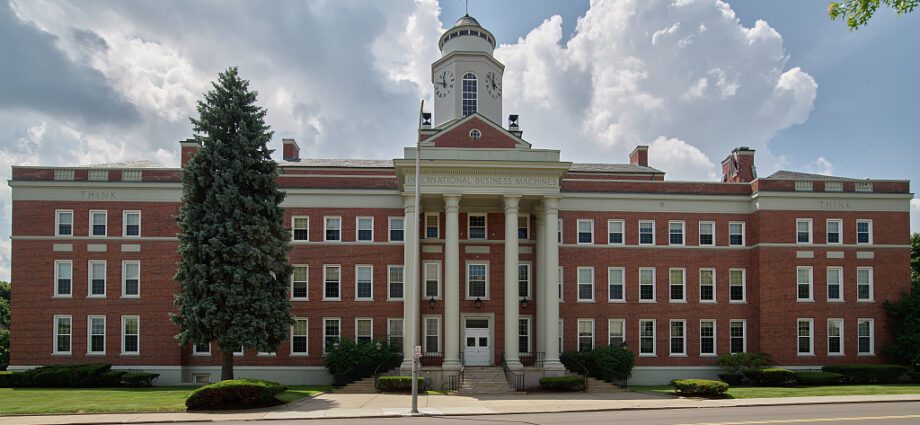As IBM runs ads this summer to burnish its Watson and AI brands during Wimbledon, it has fully walked away from and discarded the village of its birth, Endicott, New York.

There is no place more associated with IBM than Endicott, which is situated near Binghamton. Last year, the company announced that it was leaving town fully, closing out its last desk space. The region and village now hopes for an unlikely outside savior. Developers Phoenix Investors have renamed surviving parts of the facilities the Huron Campus, ignoring the IBM identity. Some buildings have been fixed, but they plan many other demolitions. The region is supposed to be the home of a lithium-ion battery plant, iM3NY, funded by the feds. Good luck on that.
IBM has left the town a mess. It’s what happens when a Hallmark movie goes wrong, and the evil guy steals away the soul of the town. Their office campus can be seen below in a new video from documentarian Sabbatical, just published. The globetrotting travel photog tours many of these abandoned upstate New York towns in a new series.
Many of these towns are pitiful. Most, however do not have the potential, or the fame, of Endicott, literally the true birthplace of the computer and the modern office. Endicott is also the original home of the Square Deal. (There is a handsome Square Deal arch in the town). The modern preservation group DoCoMoMo wrote about the whole IBM complex a decade ago, sensing its potential. They, and their expertise in sorting out the valuable parts, have been ignored. The potential includes the legacy of some of the greatest inventors and industrial designers of history.
In 2014, Julia Walker surveyed the ruins for DoCoMoMo (a link to the full story is below). She wrote:
Like so much of the architecture typical of the so-called “Rust Belt,” the band of economically depressed former manufacturing cities dotting the landscape between Illinois and New York, IBM Endicott runs a strange relay between the invisible and the visible. For the rest of the country, IBM’s tenancy in Endicott has been largely forgotten; the company’s image is far more indelibly associated with its mid-century headquarters in New York City or its Ludwig Mies van der Rohe-designed offices in Chicago. For visitors or those passing through the Endicott area, the campus often rears into view unexpectedly, a surprise encounter with this forgotten past, a curiosity, a fascinating and photogenic ruin easily Instagrammed and easily forgotten. For many residents of Endicott, however, it is highly and even painfully visible, a reminder of the distance between the city’s flourishing past and its difficult present. That the buildings have been neglected does not mean that they have ceased to exist, and the current taste for ruins in our national imaginary does not make it easier to cohabitate with them on the ground.
DoCoMoMO, Plant #1
The city continues to inspire and intrigue visitors. But each year, there is less and less of it left.
The radio station WNBF reported on the demolition of the IBM Country Club, which came after it had been abandoned and graffiti covered. The club had been a free amenity for all of its employees, but budget cuts doomed it. In most cities, these sorts of places can continue on, and be converted into a resort, or turned over to locals. But in Endicott, IBM and the village were not even able to keep it open. In a supreme irony, the Endicott tennis courts are shuttered, as their highly paid marketing and c-suite people surely hang out at the All England Tennis Club this week. Meanwhile, the locals were content to take home bricks before demolition, as souvenirs to remember the company when it was a decent employer.
Below, a look at the courts recently.

The roots of IBM are the Computing-Tabulating-Recording Company, founded in Endicott on June 16, 1911. The company used technology invented by Herman Hollerith of Georgetown, D.C., who came up with the idea of punch cards to help with the U.S. Census.
The company came about with the merger of three computing companies, the International Time Recording Company, The Tabulating Machine Company, Computing Scale Company, and Bundy Time Recording.
Such was the symbolic importance of Endicott that Ronald Reagan campaigned there in 1984. The town was different then. He said:
“Scores of the IBM workers were sons and daughters of immigrants who had worked in the shoe factories. When they began, the best market researcher predicted that fewer than 1,000 computers would be sold in the entire 20th century. Well, IBM’s first model sold almost twice that number in just 5 years, and now there are IBM plants in Endicott and around the world. And the computer revolution that so many of you helped to start promises to change life on Earth more profoundly than the Industrial Revolution of a century ago.”
“Already, computers have made possible dazzling medical breakthroughs that will enable us all to live longer, healthier, and fuller lives. Computers are helping to make our basic industries, like steel and autos, more efficient and better able to compete in the world market. And computers manufactured at IBM Owego — where some of you work — guide our space shuttles on their historic missions. You are the people who are making America a rocket of hope, shooting to the stars.
Remarks at a Reagan-Bush Rally in Endicott, New York
In a press release this week, IBM is promoting the use of AI in sports, particularly at Wimbledon. But that usage is mostly about the end user, and providing data to spectators in seats, or at home on TV. It’s all consumption. In a press release, Jonathan Adashek, senior marketing v/p for IBM, wrote that the new “Catch Me Up” feature is an “exciting example of how we can use the power of generative AI to deliver compelling, insight-driven storytelling at scale.”

He touted the 35 years that IBM and Wimbledon have been “co-creating solutions that make fans feel more connected to all the on-court action, and our new research confirms they are beginning to understand the positive impact technologies such as generative AI can have on their digital experiences. IBM is also putting these same technologies from our AI and data platform watsonx into the hands of clients worldwide, across nearly every sector, to address their unique business needs.”
That is of course all true. But the appeal of Wimbledon is people, not AI. What we look for, above the little graphics of where the tennis ball landed, or the scores, or the speeds, are the faces of the players, the fans and the Wimbledon line judges and ball boys, all dressed up. We all wish the ability to be there, in person.

What IBM did in its greatest days was connect people to machines, so they could be better, more productive. After all, Herman Hollerith’s tabulator (seen at right) was created to help census workers do better and faster work, and free the process from the drudgery. IBM freed secretaries to run spreadsheets, and empowered everyday employees to do incredible things through reservations systems, mainframes and PCs.
The companies that come in, pave over a town, change it, and then leave after a century ultimately destroy capitalism by discrediting its utility. Looking at Endicott today, one might wonder. What was it all for? Can we trust a system that builds up such great things, asks people to THINK, and then throws it all away. A few trivial STEM scholarships, or some hoped for federal battery factory program, are no substitute for individuals of vision and goodwill.
Locals are weary, and often do not have vision. The Endicott Mayor Nick Burlingame seems to be a decent fellow, but he is oddly applying for a $6 million “Restore New York” grant to tear down a number of the buildings yet still. They are waiting for the New York State Office of Historic Preservation to allow it. “SHIPBOW is requesting more due diligence just to make sure that the buildings can not be salvageable, can not be rehabbed,” Mayor Nick Burlingame said to a local news station 12, WBNG, earlier this month. “We don’t foresee that as a roadblock because we know the conditions of the buildings.”
The buildings are built like tanks. There is very very likely no actual reason for demolition, other than they are embarrassing.
Perhaps the mess that companies like IBM have created, in places like Endicott, could have been expected.
In December of 2023, the non-profit America 1st Legal filed a federal civil rights complaint against IBM. The compliant came after investigative reporter James O’Keefe released a recording of IBM Chief Executive Officer and Board Chairman Arvind Krishna promising to fire, demote, or deny bonuses to corporate executives who either fail to meet the corporation’s racial, national origin, and sex-based hiring quotas, or who hire too many Asians. It came at the same time that Red Hat subsidiary Chairman Paul Cormier admitted to terminating employees who did not meet their quotas. Below, the video:
We doubt many of the locals in Endicott would meet the racial profile needed by IBM.
Krishna reportedly made a salary package of $20 million last year, when his average employee made $65,000 a year, and base salary was $45,000. Krishna’s salary was a 23 percent increase over the previous.
CEO Arvind Keisha. Think.








